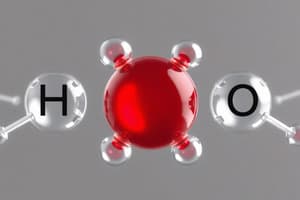Podcast
Questions and Answers
What is a chemical bond?
What is a chemical bond?
The force that holds two atoms together.
What is a cation?
What is a cation?
A positively charged ion.
What is an anion?
What is an anion?
A negatively charged ion.
What is an ionic bond?
What is an ionic bond?
What is an ionic compound?
What is an ionic compound?
What is a crystal lattice?
What is a crystal lattice?
What is lattice energy?
What is lattice energy?
What is a formula unit?
What is a formula unit?
What is a monatomic ion?
What is a monatomic ion?
What is a polyatomic ion?
What is a polyatomic ion?
What is an oxyanion?
What is an oxyanion?
What is the electron sea model?
What is the electron sea model?
What are delocalized electrons?
What are delocalized electrons?
What is a metallic bond?
What is a metallic bond?
What is an alloy?
What is an alloy?
Describe what holds atoms together in a chemical bond.
Describe what holds atoms together in a chemical bond.
Explain the process of ion formation.
Explain the process of ion formation.
What are the characteristics of a metallic bond?
What are the characteristics of a metallic bond?
How does the electron sea model account for the physical properties of metals?
How does the electron sea model account for the physical properties of metals?
What are alloys and how can they be categorized?
What are alloys and how can they be categorized?
How does ion formation relate to electron configuration?
How does ion formation relate to electron configuration?
How do ionic bonds form and how are the ions arranged in an ionic compound?
How do ionic bonds form and how are the ions arranged in an ionic compound?
What is the formula unit and how does it relate to ionic compounds composition?
What is the formula unit and how does it relate to ionic compounds composition?
How do you write formulas for compounds formed from different ions and oxyanions?
How do you write formulas for compounds formed from different ions and oxyanions?
What are the naming conventions for ionic compounds and oxyanions?
What are the naming conventions for ionic compounds and oxyanions?
Flashcards are hidden until you start studying
Study Notes
Chemical Bonds
- Chemical bonds are forces that hold atoms together through attractions between positive nuclei and negative electrons or between positive and negative ions.
Ions Formation
- Cations are positively charged ions formed when an atom loses valence electrons to achieve a stable noble gas configuration.
- Anions are negatively charged ions formed by nonmetals gaining electrons to reach a stable outer electron configuration.
Ionic Compounds
- Ionic compounds contain ionic bonds, which are electrostatic forces that hold oppositely charged ions together.
- A formula unit represents the simplest ratio of ions in an ionic compound.
- Oxyanions are polyatomic ions featuring a nonmetal element bonded to one or more oxygen atoms.
Crystal Structure
- Crystal lattice refers to the three-dimensional geometric arrangement of ions in ionic compounds, promoting stability.
- Lattice energy is the energy needed to separate one mole of ions in an ionic compound, indicating the strength of the ionic bonds.
Electron Behavior in Metals
- The electron sea model explains metallic bonds, suggesting that metal atoms contribute valence electrons to form a sea of delocalized electrons, contributing to conductivity and malleability.
- Delocalized electrons are free to move, leading to the characteristic properties of metals.
Metallic Bonds and Alloys
- Metallic bonds arise from the attraction between metallic cations and surrounding delocalized electrons, enabling unique metallic properties.
- Alloys are mixtures of elements that have metallic properties, categorized based on the elements involved and their arrangement.
Naming and Writing Formulas
- To write formulas for compounds formed from different ions, identify the total charge and find the smallest number that is evenly divisible by both charges; this gives the number of electrons transferred.
- For naming ionic compounds, the cation name precedes the anion name; monatomic cations retain the element name while monatomic anions use the element's root plus -ide.
Stability and Configuration
- Ions result from atoms' attempts to achieve a stable octet electron configuration by gaining or losing valence electrons.
- In ionic compounds, ionic bonds form when one atom transfers its valence electron to another, creating oppositely charged ions that attract each other, typically aiming for eight electrons in their outer shells.
Studying That Suits You
Use AI to generate personalized quizzes and flashcards to suit your learning preferences.




